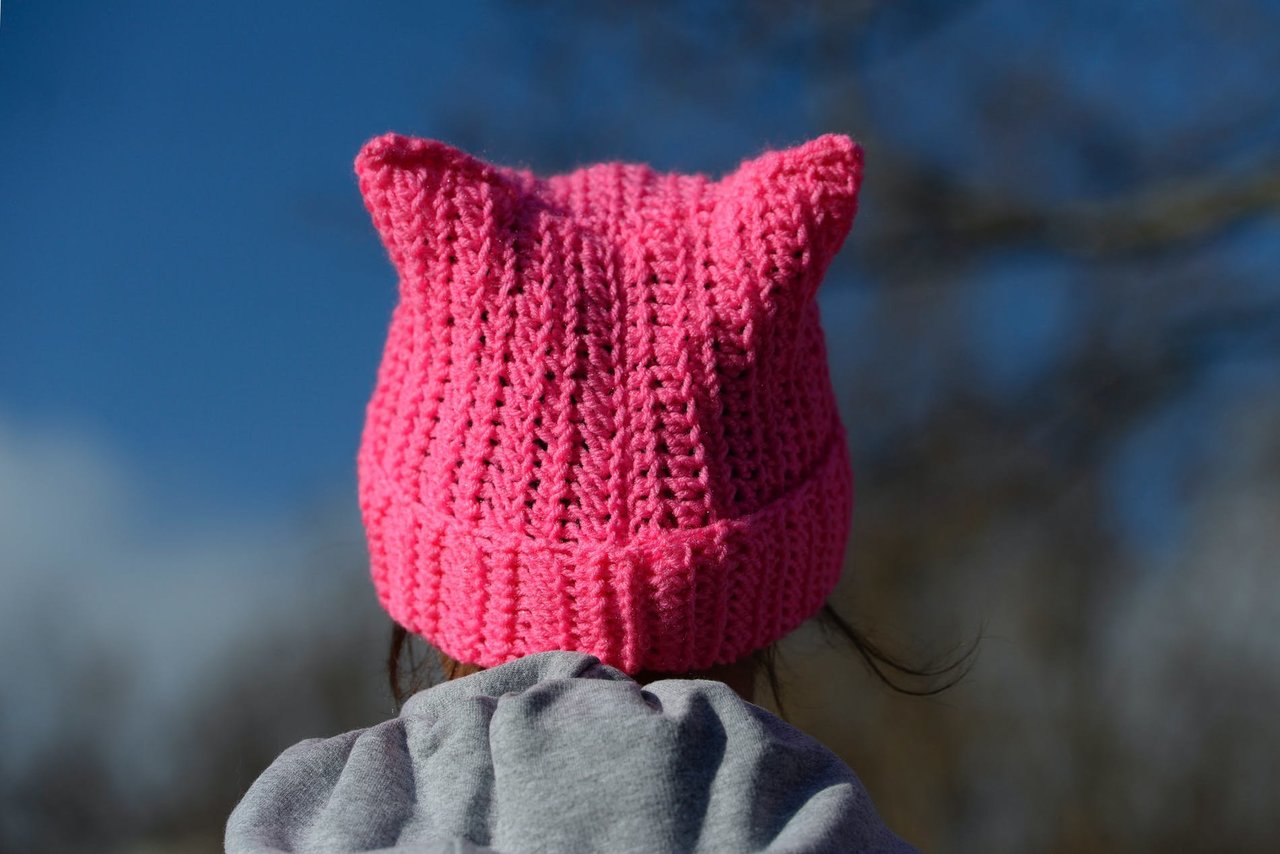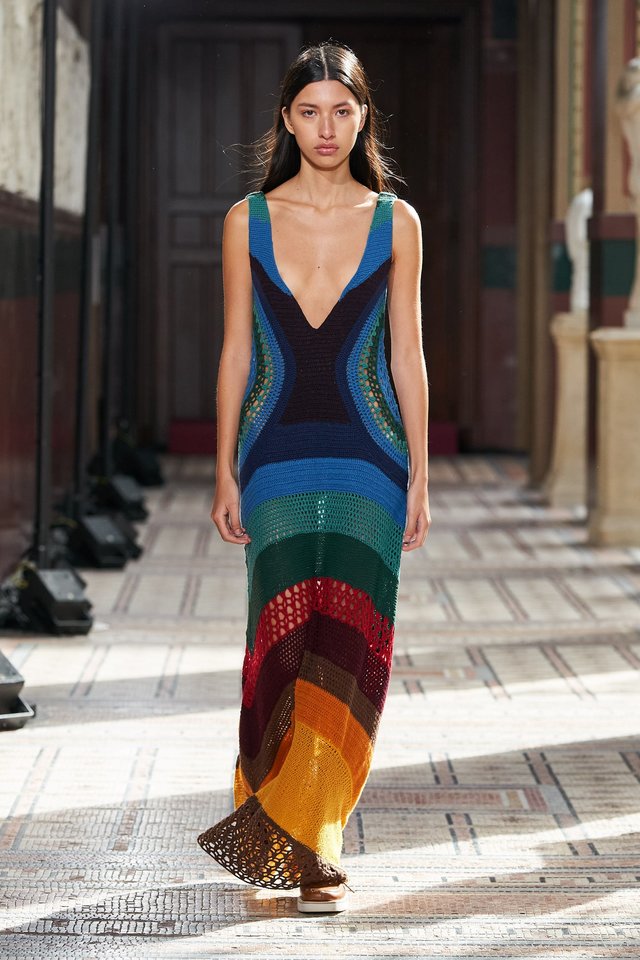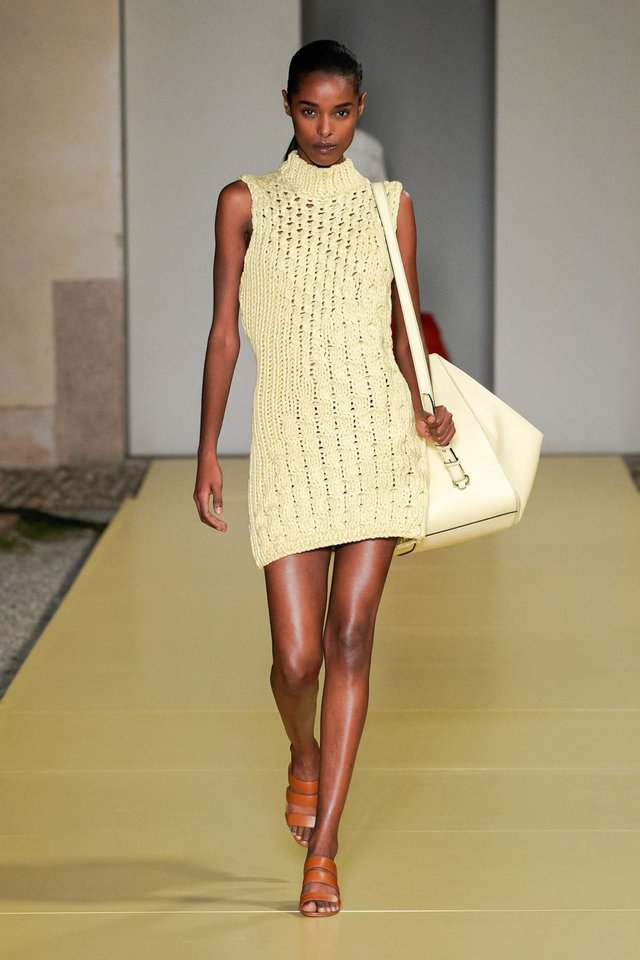There is something inherently special about a handmade garment. Over the past year, many fashion lovers have discovered the appeal of clothes imbued with a DIY spirit or craft element. For Fall/Winter 2020, Celine shared patchwork jackets, while Tom Ford stitched together different fabrics for DIY-inspired cargo pants, jeans, and skirts. Other designers drew on natural fibers reminiscent of ‘60s hippie looks. Simone Rocha and Oscar de la Renta made jewelry from the straw-like material raffia. Then for Spring/Summer 2021, crochet starred in Fendi, Salvatore Ferragamo, and Valentino's collections. Relaxed garments, many of which took inspiration from DIY processes, proved perfect for the unexpected long months of staying home.
During the pandemic, domestic arts-influenced looks made a comeback not just in high fashion, but in pop culture, too. Time at home even encouraged the creation of custom garments. Patchwork tops, split hoodies, and furry bucket hats dominated Instagram and TikTok timelines. People got back into knitting, learned embroidery, and doom-scrolled Depop for their latest cop.

Tom Ford Fall/Winter 2020
There is something inherently special about a handmade garment. Over the past year, many fashion lovers have discovered the appeal of clothes imbued with a DIY spirit or craft element. For Fall/Winter 2020, Celine shared patchwork jackets, while Tom Ford stitched together different fabrics for DIY-inspired cargo pants, jeans, and skirts. Other designers drew on natural fibers reminiscent of ‘60s hippie looks. Simone Rocha and Oscar de la Renta made jewelry from the straw-like material raffia. Then for Spring/Summer 2021, crochet starred in Fendi, Salvatore Ferragamo, and Valentino's collections. Relaxed garments, many of which took inspiration from DIY processes, proved perfect for the unexpected long months of staying home.
During the pandemic, domestic arts-influenced looks made a comeback not just in high fashion, but in pop culture, too. Time at home even encouraged the creation of custom garments. Patchwork tops, split hoodies, and furry bucket hats dominated Instagram and TikTok timelines. People got back into knitting, learned embroidery, and doom-scrolled Depop for their latest cop.

A "pink pussy" hat from the 2017 Women's March.
Given textile arts’ close, complex relationships to both the notions of home and gender, it feels appropriate that we utilize these crafts and their associated aesthetics to process the current moment. Historically, especially in America and Europe, clothing and textile creation were a vital part of the perceived domestic sphere, which made them considered women’s work. Crocheting, embroidering, sewing, and the like were not given true respect as art, but instead seen as crafts. While oft-male and otherwise privileged artists were free to use visual mediums to create objects of pure expression, female crafters were relegated to create what was primarily functional. Though most clothing production has since migrated to industrial factories, visual hallmarks of the domestic craft style remain relevant today.
Textile arts played a huge role in protest art used during the second wave feminism movement of the 1970s, and participants at the 2017 Women’s March who wore hand-knit “pink pussy” hats paid homage to these practices. It is worth noting that historically, domestic crafts were often produced by not just women, but women of color or those who depended on it for their livelihood, who were hired to complete domestic labor tasks in wealthy households. The legacy of these exploitative practices still stands today in the fashion industry as luxury players like Kering, LVMH, and more often outsource embroidery work to uncredited and underpaid artists in India.
Over generations, communities of artists across the country have created distinct, innovative styles, techniques, and aesthetics in folk art practices. For example, the quilts of Gee’s Bend, Alabama, have become famous across America. In Gee’s Bend, a community of Black artists creates quilts that, according to the New York Times, “reflect a collective history and deep sense of place” and “register the bold individual voices of the women who made them.” Work from the region hangs in the likes of the Museum of Modern Art, the de Young Museum, and the Whitney Museum of American Art, where the current Making Knowing: Craft in Art 1950 to 2019 exhibition explores the intersections of home spaces and creativity. The exhibit feels particularly needed right now, not just because of potential impending stay-at-home orders, but also because of continued other-ing and discounting of marginalized artists relegated to work in historically less prestigious domestic craft mediums.
1610041171886532 whitney museum making knowing craft art

Exhibition view of "Making Knowing Craft in Art 1950 to 2019" at the Whitney Museum of American Art.
At first glance, it might seem odd that high fashion looks are increasingly designed to appear as if one could replicate them at home. However, what makes garments special is not inaccessibility, but the care and time that goes into their design and construction. When an object is quilted or hand-woven, it symbolizes the sheer amount of labor and artistry that has gone into its creation. When designers send macrame and crochet items down the runway, they reference work by past artists, alluding to uncredited legacies of creativity and innovation. Though some have used domestic craft-influenced styles to appropriate or take credit for the work of others-like when Isabel Marant seemingly copied and took credit for designs indigenous to Santa Maria Tlahuitoltepec in Oaxaca, Mexico-others understand that using textiles connected to acts of domestic care evokes a deep sense of meaning, recognizing legitimate art forms created by those locked out of anything resembling art world spaces. By creating in larger traditions grounded in more accessible textiles, designers create garments with greater meaning-provided, of course, that proper credit is given. For example, for its men's Pre-Fall 2021 collection, Dior hired embroidery masters to adorn garments with traditional Chinese seed embroidery, a 2,000 year-old art practice where artists use small “seed” stitches to make full images.
Dior is one of many luxury houses continuing to create domestic arts-influenced looks for upcoming seasons. Gabriela Hearst, Salvatore Ferragamo, and Bottega Veneta drew heavily on crochet to create full dresses, skirts, and matching sets in their Spring/Summer 2021 collections. Balenciaga, Rick Owens, and Hermès, shared open cage knits, pared down variations on hand-knotted and woven textiles. Kenzo, on the other hand, took references to domestic life even further with a variety of different bee-keeper-esque hats of different sizes.

Gabriela Hearst Spring/Summer 2021.

Salvatore Ferragamo Spring/Summer 2021.
Plus, domestic arts-inspired looks are not only picking up steam on the runway. Quarantine has birthed an entire industry of small-scale designers who sell on social media. In the past 18 months, independent artists have helped modern DIY looks—upcycled accessories, Y2K-inspired bedazzled everything, unexpected embroidery—take over contemporary fashion as well. With a range of meanings and appearances, domestic craft and DIY-inspired looks are clearly here to stay.













